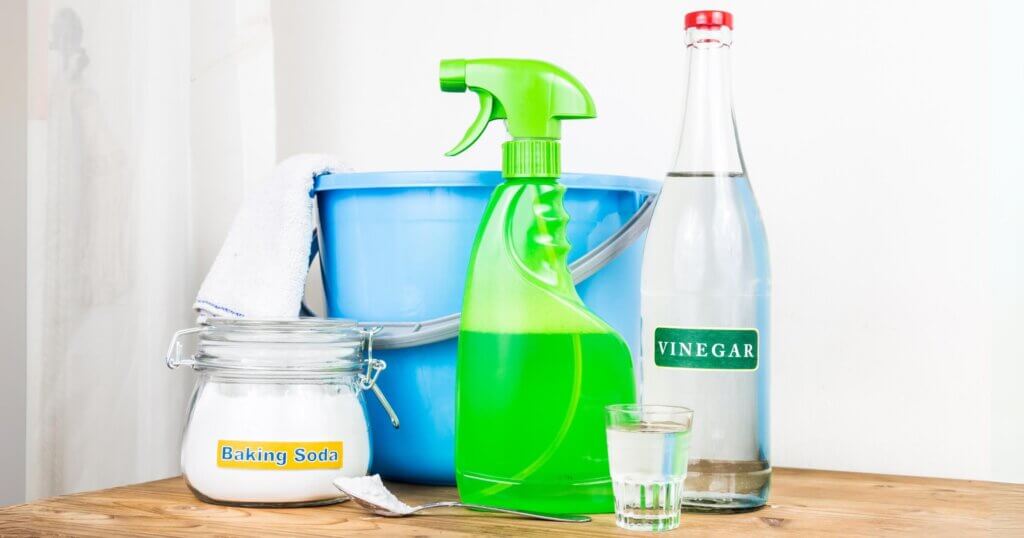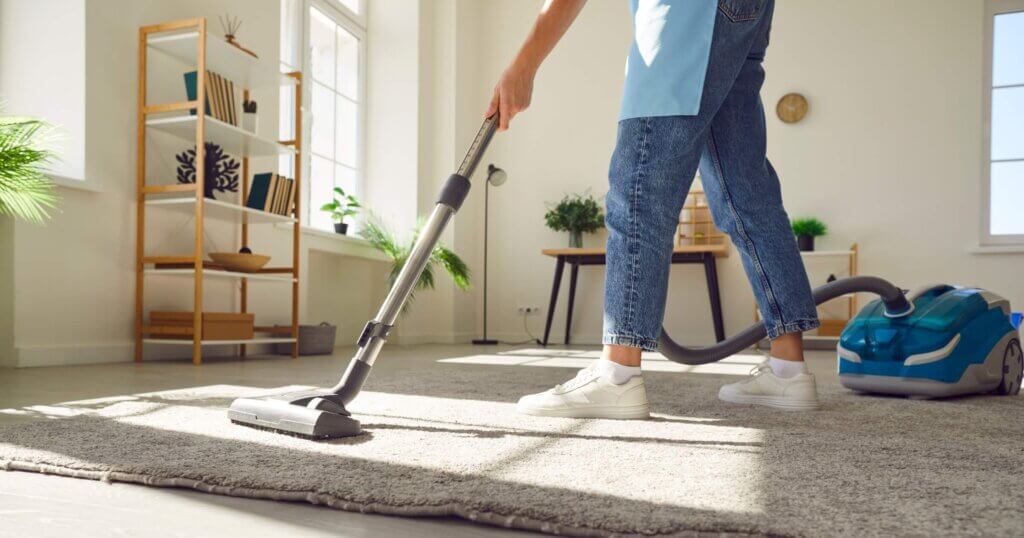Photo courtesy of https://www.shutterstock.com/
Many everyday items, such as cleaners, flooring, air fresheners, and cookware, can quietly release harmful chemicals into your living space. There are simple changes that can help reduce exposure to indoor toxins and lead to a healthier, safer home. In this guide, we cover eight simple ways you can make your home toxin-free with minimal cost.
1. Improve indoor air quality
Indoor air isn’t always as clean as you might expect. Everyday activities like cooking, cleaning, and dusting can fill your home with pollutants. In fact, indoor air is sometimes two to five times more polluted than the air outside, especially in spaces that don’t get much fresh air. Here are some simple ways to improve your indoor air quality:
- One of the simplest ways to create a toxin-free home is to improve the air quality. Regular ventilation helps flush out pollutants and bring in oxygen-rich outdoor air, especially important in tightly sealed modern homes.
- Use HEPA-filter air purifiers in bedrooms, living rooms, or areas with pets. HEPA filters are effective at removing airborne particles such as dust, pollen, and smoke, which may trigger asthma or allergies.
- Keep your home’s humidity between 30 and 50 percent. Too much moisture creates the perfect environment for mold and dust mites, which can lead to breathing issues or trigger allergies. A dehumidifier or air conditioner can help manage this, especially during humid summer months.
- Check your HVAC filters regularly. When filters are dirty, your system has to work harder and ends up recirculating dust, allergens, and other particles into the air. Replacing them every month or two is a simple way to keep the system running well and your air cleaner.
- If anyone in your household smokes indoors, consider making a change. Secondhand smoke carries thousands of chemicals, some of which are toxic or even cancer-causing. According to the CDC, keeping your home smoke-free is one of the most effective ways to protect indoor air quality.
2. Choose natural paints, finishes, and flooring
Updating your home with new paint or flooring can completely change how a space feels. But it can also bring in chemicals you may not expect. Many standard paints, varnishes, and synthetic floors give off volatile organic compounds, or VOCs, which can hang in the air long after the job is done.
To avoid that, go for low-VOC or zero-VOC paints and finishes. They’re just as easy to find as regular options and come in all the same colors and styles. Choosing products with fewer chemical emissions can help keep the air cleaner, which is especially helpful for kids or anyone with asthma.
The same goes for furniture and built-ins. Solid wood pieces finished with natural oils or water-based sealants are usually a safer bet than manufactured wood, which often contains adhesives made with formaldehyde. If something has a strong chemical smell right out of the box, it’s probably worth avoiding, especially in bedrooms or nurseries.
Natural materials like hardwood, bamboo, cork, or wool carpet are good flooring alternatives to vinyl and laminate. They typically involve fewer chemical treatments and allow the home to “breathe” more easily. Wool carpets, for example, naturally resist dust mites and stains. On the flip side, synthetic floors can release harmful compounds like phthalates and formaldehyde, particularly in the first few months after installation.
For inspiration on eco-friendly and family-first design choices, check out these top home design features for kids and modern bathroom must-haves.
3. Swap to non-toxic cleaning products and DIY solutions
Many household cleaners get the job done, but come with a hidden cost. Products that contain bleach, ammonia, or synthetic fragrances can leave behind chemical residues that affect your skin, lungs, and indoor air quality. Even that “clean” smell is often the result of irritants that linger long after the surface is wiped.
An easy place to start is by replacing bleach or ammonia-based cleaners with eco-certified alternatives. Look for labels like ECOLOGO, Green Seal, or EPA Safer Choice. These products are tough on grime, but gentler on your health and the environment leading to a toxin-free home.

Photo courtesy of https://www.shutterstock.com/
You can also make your own cleaning solutions with just a few pantry staples. A mix of vinegar and water works well for windows and countertops. Baking soda can be used to scrub sinks and tubs. To make it more refreshing, you can also mix in a little lemon juice or a few drops of essential oil for a fresh scent. These kinds of homemade cleaners are simple to put together with things you probably already have in your kitchen. You can adjust the ingredients depending on what you’re cleaning, which makes them a practical go-to for everyday messes.
No matter which products you use, store them in clearly labeled containers with child-safe lids, especially if you have little ones around.
Taking this step helps reduce daily exposure to irritants and supports a cleaner, healthier home. For more ideas that blend wellness and smart design, explore these sustainable design trends that buyers are loving in 2025.
4. Replace cookware and storage with safe materials
It’s easy to focus on the ingredients in your meals, but the pots and pans you use matter too. Some non-stick cookware is made with PFAS, a group of chemicals often called “forever chemicals” because they linger in the environment and the body. When these pans get too hot, they can release fumes that may be harmful over time.
To play it safe, ditch non-stick pans with PFAS coatings and look for safer alternatives. Stainless steel, cast iron, and ceramic cookware are all durable and free from chemical coatings. Cast iron, in particular, can even boost your iron intake slightly while you cook.
Glass jars, stainless steel containers, and silicone bags are solid alternatives to plastic for storing leftovers or packing lunches. They hold up well in the dishwasher, don’t absorb smells, and won’t leach chemicals if you heat them or store something acidic. Unlike plastic, they’re less likely to warp, stain, or break down over time.
It’s also a good idea to avoid microwaving food in plastic, even if it’s labeled microwave-safe. Heat can cause plastics to release harmful substances into your food, especially if the container is scratched or worn.
5. Eliminate synthetic fragrances and harmful air fresheners
Scented products like plug-ins or candles might seem harmless, but many of them use synthetic chemicals that aren’t great for your health. Some can trigger allergies, irritate your lungs, or mess with your hormones. The label might just say “fragrance,” but that one word can hide a long list of ingredients.
If your home depends on air fresheners to smell clean, it might be worth rethinking. Sprays, plug-ins, and scented candles often release chemicals called VOCs, which can hang in the air and cause headaches or breathing issues over time.
Fragrance-free options are a safer bet, or you can go with products scented naturally with essential oils or plant-based ingredients. When reading labels, steer clear of vague terms like “parfum” unless the full ingredient list is provided.
There are also plenty of simple, low-cost ways to handle odors. A bowl of baking soda in the fridge or bathroom can soak up smells, and charcoal bags work well in musty spots like closets or basements. If you still want a bit of scent, an essential oil diffuser with lavender or citrus can keep things fresh without the harsh chemicals. This is one of the simplest and cost effective ways to create a toxin-free home.
6. Reduce dust and chemical build-up
Dust has a way of sneaking into everything. It can include things like pollen, pet hair, flame retardants, and even tiny bits of plastic. All of that settles into carpets, furniture, and curtains. Staying on top of it with regular cleaning helps keep your space healthier and the air easier to breathe.
Start by vacuuming regularly with a HEPA-filter vacuum. HEPA filters are designed to trap tiny particles that standard vacuums often release back into the air. Focus on high-traffic areas, rugs, and upholstered furniture at least once a week to keep them clean and fresh.

Photo courtesy of https://www.shutterstock.com/
When dusting, use a damp cloth instead of a dry one. A damp surface traps dust more effectively and keeps it from getting stirred up into the air. Microfiber cloths work especially well for this and can be washed and reused.
It also helps to remove your shoes at the door. Shoes can track in dirt, pesticides, heavy metals, and other outdoor pollutants that settle into carpets and floors. A simple shoe rack or entry mat can go a long way toward keeping contaminants out.
Finally, wash bedding, curtains, and other soft furnishings often. These fabrics collect dust, skin cells, and allergens over time. Washing them in hot water helps reduce buildup and keeps your home feeling fresh.
7. Integrate air-purifying plants
Some houseplants can actually help improve air quality by soaking up small amounts of indoor pollutants. Plus, they make a room feel more relaxed and lived-in.
Low-maintenance greenery like snake plants or peace lilies are tough, don’t need much water, and have been studied for their potential to reduce common toxins like formaldehyde. Even one or two can make your space feel fresher to create a toxin-free home.
Just be careful not to overwater them. Too much moisture creates mold in the soil, especially if drainage is poor. Let the soil dry out between waterings and make sure each pot has proper airflow. With a little care, these plants can be a simple way to support a fresher, more balanced indoor environment.
To get the most out of your plants, combine them with good airflow and natural light. Place them near windows or in areas with regular circulation so they can do their job.
8. Reduce plastics and single-use items
Plastic shows up all over the house, especially in the kitchen. Many containers, wraps, and bottles are made with chemicals like BPA or phthalates, which can leach into food and drinks. Over time, repeated exposure to these substances has been linked to hormone disruption and other health concerns.
If you’re trying to use less plastic, a good place to start is with the stuff you throw out after one use. Swap out plastic wrap, bottled water, and takeout containers for things that last. Beeswax wraps are great for covering food, and glass jars or stainless steel containers work well for leftovers and lunches.
When you’re shopping, take a look at the labels. Some plastics are made without BPA or phthalates, but not all of them make that clear. If something will be used with hot food or in the microwave, it’s worth choosing a safer option.
You don’t have to make grand sweeping changes all at once. Starting with a few small switches can make your kitchen feel cleaner and less wasteful. Over time, those small choices can have a cumulative impact on your health and the environment.
Key takeaways
Creating a healthier, toxin-free home starts with small switches, like upgrading to a HEPA-filter vacuum or replacing synthetic air fresheners. Over time, these small changes make a difference in how your space looks, feels, and functions.
Pick one or two swaps that feel manageable, like switching to a natural all-purpose cleaner or replacing a non-stick pan, and then add to them. Small steps like these are easier to stick to, especially when starting out.
For more healthy home tips, wellness ideas, and innovative design insights delivered straight to your inbox, subscribe to our newsletter.


